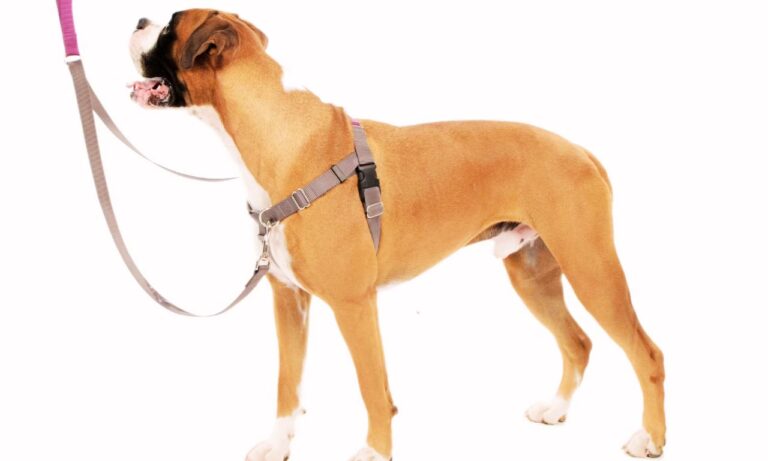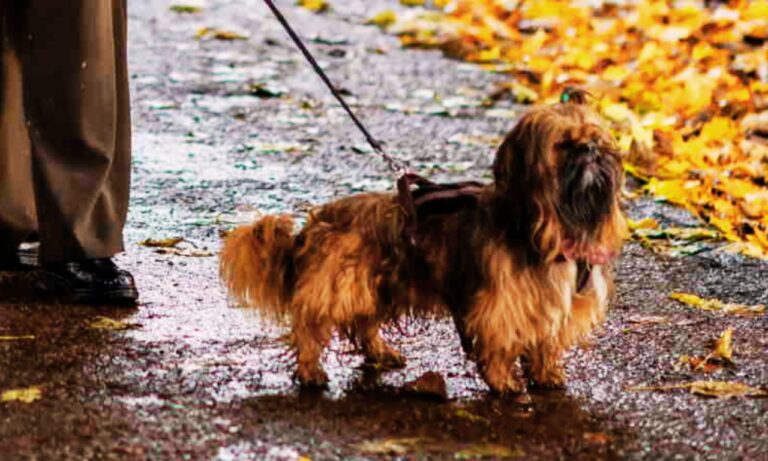The neck injury of dogs are the cause of significant discomfort and anxiety, usually being unnoticed until symptoms are more acute. In contrast to humans, dogs are unable to communicate pain, which makes it vital for pet owners to remain attentive to the changes that occur in their dog’s behavior.
Suppose the discomfort outcome is due to trauma or is the result of the absence of any obvious motive. In that case, it’s crucial to identify the signs in a timely manner and seek out veterinary attention. I’ll tell you the symptoms of neck injury in dogs. Ensure your dog’s collar is positioned correctly for their comfort by checking out where a collar should sit on a dog’s neck.
Blog Highlights
ToggleWhat is Neck and Back Pain Injury in Dogs?
Back and neck pain are common in dogs and may result from a variety of medical issues. Because our dogs are unable to communicate their pain, determining the root of the problem can be difficult.

As pet owners who are responsible, we should pay attention to any behavior changes that could be indicative of pain, like a reluctance to move, stiffness, or vocalizations of displeasure. These symptoms could range from mild discomfort up to intense, debilitating pain, and the root cause may differ widely.
If your dog has sensitive skin, finding the best dog collars can keep them comfortable and irritation-free.
The intensity and length of the pain will depend on the condition affecting the dog’s neck or spinal cord. Urgent veterinary care is required in the event that any signs of pain are noticed to prevent further complications. Finding the best e-collar for large dogs can make training more effective and less stressful.
What Are the Symptoms of Neck Injury in Dogs?
The early recognition of neck pain symptoms can greatly increase the chances of a positive outcome for your dog. Here are the symptoms of neck injury in dogs:

- Lowered head position: A dog with neck pain could keep his head lower, even when standing, to ease discomfort.
- Stiffness or restricted movement: The dog may experience difficulty turning its head to the side or exhibit indications that its neck muscles are stiff.
- Neck muscle spasms: Involuntary spasms within the neck muscles may be an indication of tension.
- Resistance to change: A dog that is suffering may not want to jump onto the furniture or get off it, walk upstairs, or even leave one location for another.
- Vocalizations: The sound of crying, whimpering, or yelping after the body or object is touched are obvious indications of discomfort.
- Walking slowly or cautiously: Dogs can stroll slower or with more care in order to avoid aggravating their pain.
- Trouble drinking or eating: If your dog isn’t willing to lower its head in order to drink or eat from a bowl placed on the flooring, it could be due to neck pain.
Common Causes of Neck Injury in Dogs
A variety of reasons, such as cancer, infections, injuries, and neurological disorders, could cause dogs suffering from neck pain. One of the most common causes is cervical disc disease, particularly in certain breeds. Curious if barking collars are effective? Here’s what you need to know.

Cervical Disc Disease
Cervical disc disease, a kind of intervertebral disc disorder (IVDD), is a condition that specifically affects the neck (cervical spine) in dogs. This is a condition that occurs when discs between vertebrae in the spine become degenerated, dry out, and eventually rupture. The pressure that results upon the spine may cause a variety of symptoms, ranging from minor discomfort or paralysis to serious.
Certain dog breeds are more susceptible to developing cervical disc problems due to genetic reasons. Dachshunds, French Bulldogs, Chihuahuas, and Beagles are at a higher risk of developing symptoms early in life.
What is Cervical Disc Disease in Dogs?
Cervical disc problems are characterized by the degeneration and rupturing of intervertebral discs within the neck, causing an improvement in pressure on the spinal cord. The condition is similar to the condition that is generally referred to as bulging, slipped herniated, or ruptured disc. Worried about using a shock collar? Learn whether shock collars hurt dogs and explore safer alternatives.

Symptoms of Cervical Disc Disease
The signs and symptoms of cervical disc disease may vary greatly depending on the extent of the problem. In some instances, the sole sign could be neck pain. However, other dogs could show more severe symptoms, for example:
- The ailment in all four legs: The dog may be able to walk, but its walk may appear uneven, and it could stretch or cross its legs or even knuckle its paws underneath.
- The inability of a dog to walk: In more serious instances, dogs might not be strong enough to walk, but they can move their legs.
- Paralysis: Dogs with certain breeds may suffer from paralysis, with or without the capacity to feel their feet.
Veterinarians frequently employ a grading system to determine the extent of cervical disc diseases:
- Grade 1: The dog has only neck pain but does not suffer from neurological issues.
- Grade 2: A lack of strength in all four limbs. However, the dog will still walk.
- Grade 3: The dog is not strong enough to walk. However, it is able to move its legs.
- Grade 4: A dog becomes paralyzed but retains a sense of touch in its toes.
- Grade 5: Dog is paralyzed and can’t be able to feel his feet.
What Are the Major Treatment Options for Neck Injury in Dogs?
The treatment of back and neck pain in dogs depends on the root cause and the extent of the issue. Certain cases might require medications and rest, whereas others require more intensive treatments like surgery.
1. Non-Surgical Treatment
Infections or minor injuries can be treated with antibiotics, anti-inflammatory drugs, and a strict rest regimen. If the pain is caused by disc injuries or a similar issue, resting the cage for a few weeks is required to allow the issue to heal. Anti-inflammatory and pain relievers are frequently prescribed to ease the pain.
2. Surgical Treatment
More serious cases, specifically those that involve the spinal cord or cancer, might require surgery. The kind of surgery required and the likelihood of recovery will be based on the particular medical condition as well as the severity of the damage or disease.
For a cleaner, healthier litter box, consider these natural cat litters that are top choices for 2024.
The Prognosis and Recovery for Dog’s Neck Injury | 9 Treatment Options
The healing process for dogs suffering from back or neck pain can differ greatly depending on the root cause, severity, and method of treatment.

1. Cage Rest:
One of the main guidelines for dogs suffering from back or neck discomfort is strict resting in the cage. This means confining the dog in a small room that is comfortable and where their movements are restricted. The objective is to stop any further strain on the spine or neck and allow the body to heal itself. Resting the neck or spine may be recommended for between 4 and 6 weeks, based on the seriousness of your issue.
2. Activity Limitation:
In addition to resting in the cage, pet owners may also have to limit their dog’s physical activity. This could include not running, jumping, or climbing steps, all of which could cause more harm to the dog. A short, controlled walk may be allowed with the supervision of a vet.
3. Pain Relievers:
Non-steroidal anti-inflammatory medicines (NSAIDs) are typically used to reduce inflammation and pain. These medicines are able to focus on providing immense relief for dogs suffering from neck or back discomfort, allowing them to sleep more comfortably.
Muscle relaxants are recommended for dogs who experience stiffness or muscle spasms to relieve tension in the affected area. These drugs reduce discomfort and increase mobility.
4. Corticosteroids:
In certain instances, corticosteroids can be utilized to control the severity of swelling and inflammation, especially in conditions such as IVDD. Due to the possibility of negative side effects, these medicines are usually used for short-term treatment under veterinary supervision.
5. Antibiotics:
In the event that an infection has been determined to be the root of the discomfort, antibiotics are needed to address the root of the infection. Alongside the use of antibiotics, rest and extra assistance could be necessary to ensure a complete recovery.
6. Physical Therapy:
Like human beings, physical therapy may be a key factor in the healing process of dogs suffering from back and neck pain. Techniques like stretching exercises, passive range-of-motion exercises, and massages can help increase muscle mobility, increase strength, and lessen pain.
It is essential that physical therapy be administered by a qualified, skilled professional to ensure that the procedure is carried out correctly and definitely.
7. Hydrotherapy:
Water therapy, also known as hydrotherapy, is yet another noninvasive alternative treatment. Water’s buoyancy permits canines to move their legs and exercise without putting stress on their necks and spines. This is especially beneficial to dogs recovering from surgery or suffering chronic pain that hinders their mobility.
8. Acupuncture:
Acupuncture is an ancient Chinese practice that involves the insertion of fine needles into specific locations on the body. It has been proven to give relief from pain and aid in healing in dogs suffering from muscle and joint issues. Acupuncture may benefit from decreasing swelling, improving blood flow, and releasing natural pain-relieving chemicals in the body.
9. Chiropractic Care:
Chiropractic care for veterinary patients involves manual adjustments to the spinal column to correct misalignments that might cause discomfort. This procedure is typically employed alongside other treatments to improve spinal health and relieve discomfort.
Prognosis
The outlook for dogs suffering from back or neck pain depends on many aspects, including the extent of the problem, the treatment that is given, and the overall health of the dog. If there is significant damage to the nerve or loss of feeling, the outlook may not be favorable. However, by pursuing prompt and effective treatment, a lot of dogs will recuperate and return to a high quality of life.
Wondering what it means if a dog wears a red collar? Here’s why it’s important to know.
Conclusion
Neck injuries in dogs can be a serious issue that requires immediate care. If you are aware of the symptoms of neck injury in dogs and options for treatment, dog owners are able to take essential steps to ensure that their pets receive the treatment they require. Early detection and treatment are crucial to reducing neck discomfort in dogs, which allows them to lead healthy and enjoyable lives.





